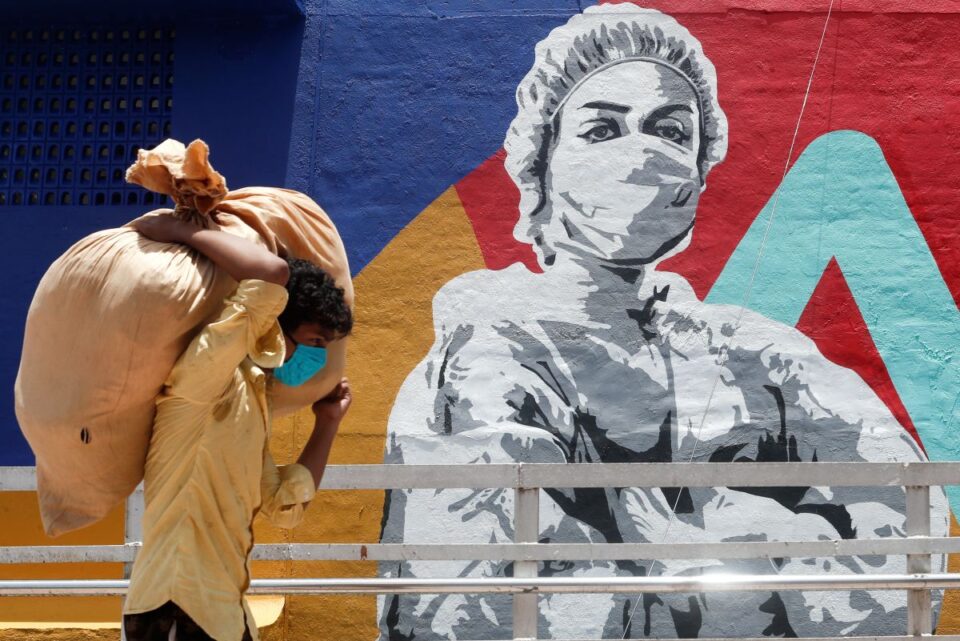The panel also stated that without the lockdown the country would have witnessed a peak of over 140 lakh cases.
IMAGE: A man carrying a sack walks past a graffiti of a healthcare worker during a lockdown to slow the spread of the coronavirus disease in Mumbai. Photograph: Francis Mascarenhas/Reuters
No fresh lockdowns should be imposed on district or state level to contain the spread of COVID-19 unless there is an imminent danger of healthcare facilities being overwhelmed, according to a government-appointed committee chaired by IIT Hyderabad professor M Vidyasagar.
The committee has also claimed that if all protocols are followed, the pandemic can be controlled by early next year with minimal active symptomatic infections by February-end.
The 10-member panel which conducted a study on “Progression of the COVID-19 Pandemic in India: Prognosis and Lockdown Impacts” has pointed out that with no lockdown, the pandemic would have hit India very hard with a peak load of over 1.40 crore cases arriving in June.
The committee has developed an evidence based mathematical model for COVID-19 progression. The national level ‘super model’ is based on various parameters such as timing of the lockdown, alternative lockdown scenarios, impact of migrant workers returning to their homes, and future course of the pandemic including impact of not following safety protocols.
“If all of us follow these protocols, the pandemic can be controlled by early next year with minimal active symptomatic infections by February-end. We do not yet know the weather-specific perturbations of this pandemic (in general, viruses tend to be more active in colder environment) and the effects of possible future mutations in the virus.
“Hence, the existing personal safety protocols need to continue in full measure. Otherwise we will see a sharp rise in infections. Fresh lockdowns should not be imposed on a district and state wide levels, unless there is imminent danger of the healthcare facilities being overwhelmed,” Vidyasagar said.
The committee including professors from IITs and IISc besides scientists, said that upcoming festival and winter seasons may increase the susceptibility to the infection but all activities can be resumed provided proper safety protocols are followed.
It also noted that the imposition of an early and comprehensive lockdown pushed the peak of cases far into the future and also reduced the peak load on the system.
“With no lockdown, the pandemic would have hit India very hard, with a peak load of over 140 lakh cases arriving in June. Given our lack of preparedness back then, the healthcare system would have been
overwhelmed, leading to many additional deaths. Had India waited until May to impose the lockdown, the peak load of active cases would have been around 50 lakhs by June,” the panel report said.
“In actuality, the peak of active cases came in late September at around 10 lakhs. By this time, we were far better equipped to handle the pandemic in terms of diagnostics and vital equipment inventories. Without a lockdown the number of deaths in India would have overwhelmed the system within a very short time frame, and would eventually have crossed 26 lakhs fatalities,” it added.
Based on temporal profiles of analyses done for Bihar and Uttar Pradesh, the committee concluded that the impact of labour migration on the total number of infections in these states was minimal.
The committee also asserted that the imposition of various safety protocols such as wearing masks and social distancing, together with a comprehensive lockdown has allowed India to fare better than many other countries.
“India has one-sixth of the world’s population (one-fifth excluding China), and one-sixth of the reported cases. However, India accounts for only 10 pc of the world’s deaths, and its case fatality rate of less
than 2 per cent is among the lowest in the world,” it said.
The committee has recommended that the existing personal safety protocols need to continue in full measure, otherwise the country will see a sharp rise in infections.
“Avoiding congestion especially in closed spaces and special care of those above 65 years and children is even more significant. Personnel with co-morbidities need to be extra cautious,” it said.
The Department of Science and Technology had in June constituted a committee comprising eminent scientists and academicians to evolve a national supermodel for COVID-19 progression.
The mandate of the committee was to create an evidence-based mathematical model for the pandemic after taking inputs from various groups working in the domain in the country and use it to analyse past events and future trajectories of the pandemic.




